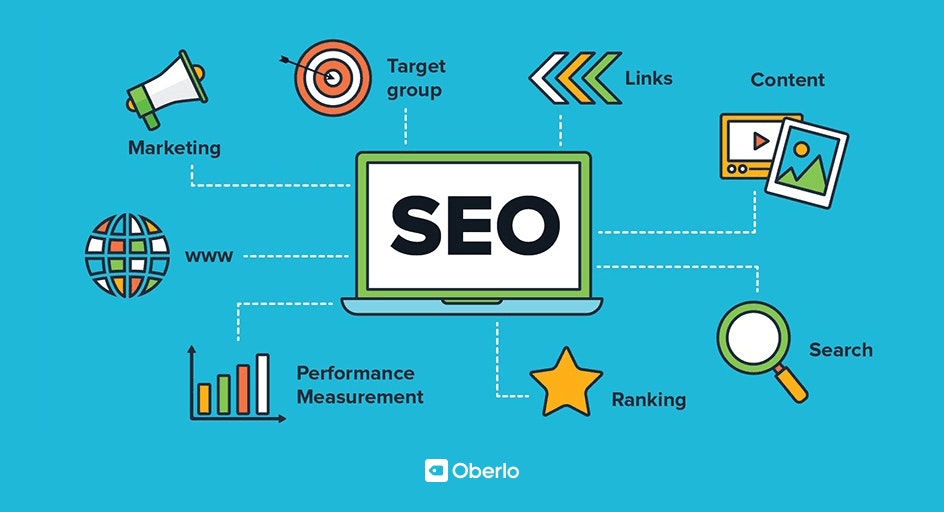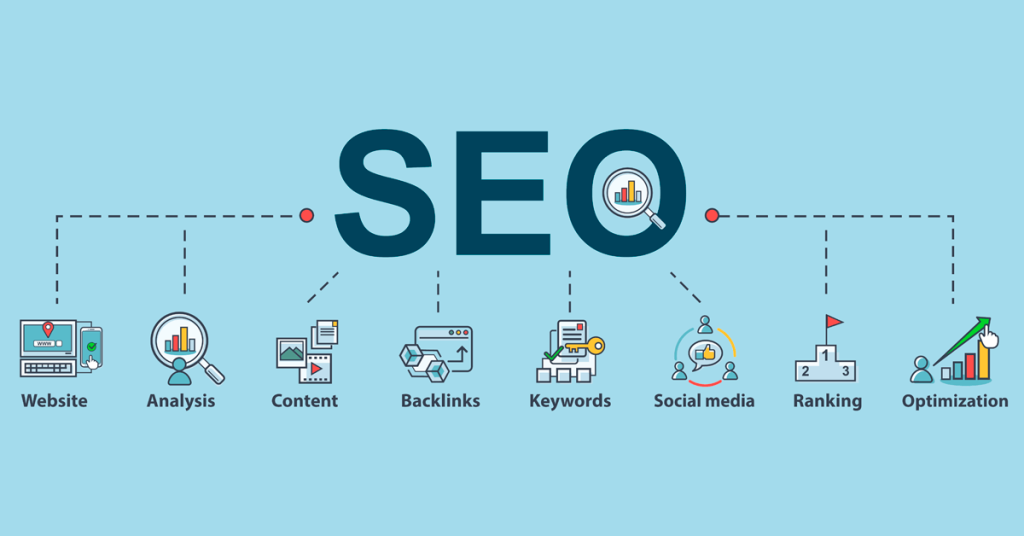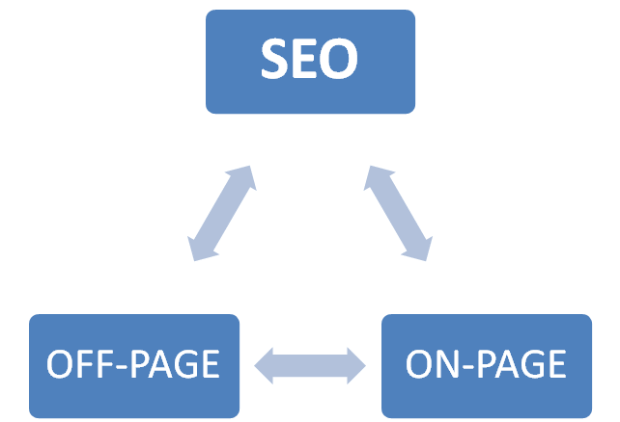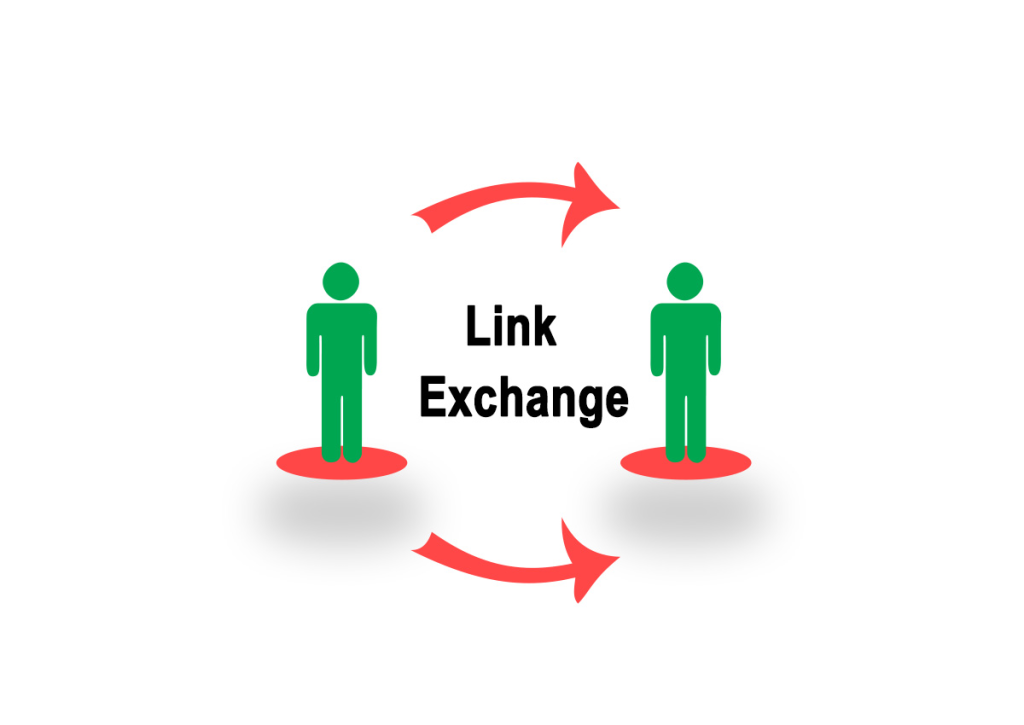
Search engine optimization (SEO) is the process of improving the visibility and ranking of a website or web page in search engine results pages (SERPs). The goal of SEO is to increase the amount of organic (non-paid) traffic to a website by improving the relevance and authority of the site in the eyes of search engines like Google.
There are several factors that contribute to a website’s SEO, including:
- On-page optimization: This involves optimizing the content and HTML source code of a website or web page, including the use of keywords, meta tags, and other elements that help search engines understand the content of the site.
- Off-page optimization: This involves building high-quality backlinks to a website or web page from other sites, which helps to increase the site’s authority and relevance in the eyes of search engines.
- Technical optimization: This involves optimizing the technical elements of a website, such as site structure, page load speed, mobile optimization, and security.

SEO is an ongoing process that requires regular monitoring and updates to stay ahead of the competition and maintain a strong online presence. Effective SEO strategies can help businesses of all sizes improve their visibility, attract more traffic, and generate more leads and revenue.
What do we understand by the term search engine?
A search engine is an online tool or software program that allows users to search for information on the internet by entering keywords or phrases related to their query. The search engine then scans its index of web pages and returns a list of results that are relevant to the user’s query.
Search engines like Google, Bing, Yahoo, and others use complex algorithms to determine the relevance and authority of web pages and rank them in search results. They also take into account a variety of factors, such as the user’s location, search history, and search intent, to provide personalized and relevant results.
Search engines have become an essential tool for navigating the vast amount of information available on the internet. They have revolutionized the way we access and consume information, making it easier and faster to find what we need. Search engines are used for a variety of purposes, from research and education to shopping and entertainment, and have become an integral part of our daily lives.
SEARCH ENGINE OPTIMIZATION
TYPES OF SEARCH ENGINE OPTIMIZATION

Off-page SEO refers to the strategies and techniques used to improve the search engine rankings of a website or web page through external factors, such as link building and social media marketing. Unlike on-page SEO, which focuses on optimizing the content and structure of a website or web page, off-page SEO involves actions taken outside of the website to improve its ranking and authority.
The main goal of off-page SEO is to increase the number and quality of backlinks pointing to a website, as backlinks are a key factor in determining a site’s authority and relevance in search engine rankings. Some common off-page SEO strategies include:
- Link building: This involves acquiring high-quality backlinks from other websites through techniques such as guest blogging, broken link building, and outreach campaigns.
- Social media marketing: This involves using social media platforms to promote a website or web page, increase its visibility, and attract more traffic and engagement.
- Influencer marketing: This involves partnering with influential people in your industry or niche to promote your website or brand and attract more backlinks and social media shares.
- Online directories: This involves listing your website or business in online directories and review sites, which can improve its visibility and authority.

Off-page SEO is a crucial component of any effective SEO strategy, as it helps to improve a website’s authority and relevance in search engine rankings. By building high-quality backlinks, promoting your website through social media and influencer marketing, and listing your site in online directories, you can improve your off-page SEO and drive more traffic and engagement to your site.
SEARCH ENGINE OPTIMIZATION
ELEMENTS OF GOOD OFF PAGE SEO
Link popularity refers to the number and quality of links that point to a particular website or web page. It is an important factor in search engine optimization (SEO), as search engines use link popularity to help determine the relevance and authority of a website or web page.
The more high-quality links a website has, the more likely it is to rank well in search engine results pages (SERPs). Link popularity can also help to increase referral traffic to a website, as people may click on links to a website from other websites they visit.

Link popularity can be improved through various SEO tactics, such as creating high-quality content that other websites want to link to, guest blogging on other websites to earn backlinks, and engaging in social media marketing to increase the visibility of a website’s content. However, it is important to note that link building should be done in a natural and ethical way, as search engines can penalize websites that engage in manipulative or spammy link building practices.
Link exchange is a type of link building strategy where two website owners agree to exchange links with each other. The purpose of link exchange is to increase the link popularity of both websites, which can help to improve their search engine rankings and drive more traffic to their sites.
The process of link exchange typically involves contacting other website owners in a similar niche or industry and proposing a link exchange agreement. If both parties agree to the exchange, they will place links to each other’s websites on their own sites.
While link exchange can be a legitimate and effective way to improve link popularity, it is important to be cautious and avoid engaging in manipulative or spammy link exchanges. For example, search engines may penalize websites that participate in large-scale or automated link exchanges, or those that engage in link exchanges solely for the purpose of improving search engine rankings rather than providing value to users.

Overall, link exchange should be approached with caution and done in a natural and ethical way, with a focus on providing value to users and building relationships with other website owners in a similar niche or industry.
Forum link building is a type of link building strategy that involves building links by participating in online discussion forums. The idea behind this strategy is to post comments or replies in forums that are relevant to your website’s niche or industry and include a link to your website in the signature or post.
While forum link building can be an effective way to improve link popularity, it is important to use this strategy carefully and avoid engaging in spammy or manipulative tactics. Here are some best practices for forum link building:
- Find relevant forums: Look for online discussion forums that are relevant to your website’s niche or industry. Focus on forums that have a high level of engagement and are likely to attract your target audience.
- Participate in discussions: Take the time to read through existing forum discussions and participate in them by posting thoughtful comments or replies. Add value to the conversation and avoid posting spammy or promotional messages.
- Include links naturally: When including links in your forum posts or signature, make sure they are relevant and add value to the discussion. Avoid using keyword-rich anchor text or posting links to low-quality or spammy websites.
- Build relationships: Forum link building is most effective when you build relationships with other forum members. Take the time to engage with other members, answer their questions, and provide helpful advice.
Overall, forum link building can be a valuable strategy for building links and driving traffic to your website, but it should be approached with caution and done in a natural and ethical way.

Posting to forums is a way to participate in online discussions and share your thoughts, ideas, and expertise with a community of people who share similar interests or concerns. Forums can be a valuable source of information and a way to connect with others in your industry or niche. Here are some tips for posting to forums:
- Read the forum rules: Before posting to a forum, make sure you read and understand the forum rules. This will help you avoid getting banned or having your posts removed for violating the forum’s guidelines.
- Choose the right forum: Look for forums that are relevant to your interests or industry. There are many forums available online, so take the time to find ones that are active and have a community of people who share your interests.
- Be respectful: When posting to a forum, be respectful of other members and their opinions. Avoid attacking or insulting others and keep your language professional and polite.
- Provide value: When posting to a forum, focus on providing value to other members. Share your knowledge and expertise, answer questions, and offer helpful advice. This will help you build a reputation as a trusted and valuable member of the community.
- Follow up: If someone responds to your post, make sure to follow up and continue the conversation. This will help you build relationships with other members and establish yourself as an active and engaged member of the community.
Overall, posting to forums can be a valuable way to share your ideas and connect with others in your industry or niche. By following these tips, you can make sure that your forum posts are effective, professional, and respectful.
SEARCH ENGINE OPTIMIZATION
ELEMENTS OF GOOD ON PAGE SEO
This is the practice of optimizing individual web pages in order to rank higher and earn more relevant traffic in search engines.
- KEYWORD RICH HEADING
A keyword-rich heading is a heading that contains relevant and important keywords related to the content of a web page. Using keyword-rich headings can be beneficial for SEO as it helps search engines understand what the page is about and can improve the page’s relevance and ranking in search results.
Here are some tips for using keyword-rich headings in SEO:
- Choose relevant keywords: Use keywords that accurately describe the content of the page and are relevant to the user’s search query. Conduct keyword research to identify relevant and high-traffic keywords.
- Use primary keywords in the main heading: Use the primary keyword or key phrase in the main heading (H1 tag) of the page. This will help search engines understand the main topic of the page and improve its relevance and ranking.
- Use subheadings (H2, H3 tags): Use subheadings (H2, H3 tags) to break up the content and make it easier to read. Use secondary keywords and related phrases in subheadings to further optimize the content.
- Keep it concise and readable: Use clear and concise headings that accurately describe the content of the page. Avoid stuffing keywords or using irrelevant headings as it can negatively affect the user experience and the page’s ranking.
- Avoid duplicate headings: Avoid using the same headings on multiple pages as it can confuse search engines and affect the ranking of both pages.
Using keyword-rich headings can help improve the relevance and ranking of a web page in search results. However, it is important to use them in a natural and user-friendly way that does not compromise the quality of the content or user experience.
2. USE OF TAGS AND KEYWORDS IN THE ARTICLE
Tags and keywords play an important role in optimizing articles for search engines and improving their visibility and ranking in search results. Here are some tips for using tags and keywords in articles:
- Choose relevant keywords: Choose relevant and specific keywords that accurately describe the content of the article and are related to the user’s search query. Use keyword research tools to identify high-traffic and low-competition keywords.
- Use primary keyword in the title: Use the primary keyword or key phrase in the title of the article. This will help search engines understand the main topic of the article and improve its relevance and ranking.
- Use secondary keywords in the content: Use secondary keywords and related phrases throughout the content of the article. This will help optimize the article for a wider range of search queries and improve its ranking.
- Use tags: Use relevant and specific tags that describe the content of the article. Tags can help search engines understand the topics covered in the article and improve its visibility and ranking in search results.
- Avoid keyword stuffing: Avoid overusing keywords or stuffing them in the article unnaturally. This can negatively affect the user experience and the ranking of the article.
- Write high-quality content: Write high-quality, informative, and engaging content that people want to read and share. This will help attract more traffic and backlinks to the article, which can improve its visibility and ranking in search results.
By using relevant and specific tags and keywords in articles, you can optimize them for search engines and improve their visibility and ranking in search results. However, it is important to use them in a natural and user-friendly way that does not compromise the quality of the content or user experience.
3. USE OF SUB HEADINGS (PREFERABLY H2)
Using subheadings, particularly H2 tags, in articles can be beneficial for both SEO and user experience. Here are some reasons why:
- Organize the content: Subheadings help to organize the content of an article into sections, making it easier for readers to navigate and understand. This can improve the overall user experience and keep readers engaged.
- Improve readability: Subheadings break up large blocks of text and make articles easier to read. They also provide visual cues that help readers understand the structure of the article and locate the information they are looking for.
- Improve SEO: Subheadings, particularly H2 tags, signal to search engines what the main topics of an article are, making it easier for them to understand and index the content. This can improve the visibility and ranking of the article in search results.
- Optimize for multiple keywords: Using subheadings can also help optimize an article for multiple keywords. By using relevant and specific keywords in subheadings, you can signal to search engines what the main topics of the article are, making it more likely to appear in search results for related search queries.
When using subheadings in articles, it’s important to use them in a logical and organized way. Use H2 tags for main subheadings and H3 tags for sub-subheadings, and make sure they accurately reflect the content of the section. Avoid stuffing keywords or using subheadings for the sake of SEO, as this can negatively affect the user experience and the ranking of the article.
Using multimedia, such as images, videos, and audio, in your story can also have a positive impact on SEO. Here are some reasons why:
- Increase visibility: By adding multimedia to your story, you can make it more visible in search results. Search engines like Google often feature multimedia content, such as images and videos, in their search results, which can increase the visibility of your story.
- Improve engagement metrics: Using multimedia can also improve engagement metrics, such as time spent on page and bounce rate. When users spend more time on your page and interact with your multimedia content, it signals to search engines that your content is high-quality and relevant, which can improve your SEO.
- Provide alternative content: Multimedia can provide alternative content that is more accessible and engaging to certain types of users. For example, some users may prefer to watch a video or listen to audio instead of reading a long article. Providing multimedia options can improve the accessibility and user-friendliness of your content.
- Increase backlinks: Multimedia content is also more likely to be shared and linked to by other websites and social media users. This can increase the number of backlinks to your story, which is an important factor in SEO.
Overall, using multimedia in your story can have multiple benefits for SEO, including increased visibility, improved engagement metrics, increased backlinks, and improved accessibility.
Captioning photos and alternative text
Captioning photos and using alternative text (alt text) can improve the SEO of your website in multiple ways:
- Accessibility: Captioning photos and using alt text is important for accessibility. It ensures that visually impaired users using screen readers or users with slow internet connections can understand what the image is about. This can improve the user experience and potentially increase engagement.
- Keyword optimization: Captioning photos and using alt text can also provide an opportunity to optimize for keywords. Including relevant keywords in the caption or alt text can help search engines understand the content of the image and improve the relevance of the page for related search queries.
- Improved image search: Captioning photos and using alt text can improve the visibility of your images in image search results. Search engines use caption and alt text to understand the content of the image and return relevant results to users.
- Improved user engagement: Captioning photos and using alt text can also improve user engagement by providing additional context and information about the image. This can increase the chances of users sharing the image or visiting the page, which can ultimately improve SEO.
When captioning photos and using alt text, it’s important to be descriptive and accurate. Use relevant keywords and avoid keyword stuffing or using inaccurate descriptions. This can negatively impact user experience and SEO.
Outbound and inbound linking are two important aspects of SEO.
Outbound linking refers to linking to other websites or resources from your own website. This can improve the credibility and authority of your website by providing additional context and resources for your audience. Outbound links can also improve SEO by signaling to search engines that your website is a valuable resource for users.
Inbound linking, also known as backlinking, refers to other websites linking back to your website. Backlinks are important for SEO because they signal to search engines that your website is a credible and authoritative source of information. Backlinks can also increase the visibility of your website in search results by improving your website’s PageRank.
When linking to other websites, it’s important to ensure that the websites you link to are reputable and relevant to your audience. This can help to improve the credibility and authority of your website. When building backlinks, it’s important to focus on quality over quantity. A few high-quality backlinks from reputable websites are more valuable than many low-quality backlinks from irrelevant or spammy websites.
Overall, outbound and inbound linking are important aspects of SEO that can help to improve the credibility, authority, and visibility of your website in search results.
HAVE A FEATURED IMAGE
Having a featured image can improve the SEO of your website in multiple ways:
- Visual appeal: A featured image can make your content more visually appealing and engaging for users. This can encourage users to click on your content and potentially increase engagement metrics, such as time spent on page and bounce rate. These metrics can signal to search engines that your content is high-quality and relevant, which can improve your SEO.
- Social media sharing: A featured image can also improve the appearance of your content when shared on social media platforms. Social media platforms often display the featured image when a link is shared, which can increase visibility and potentially drive traffic to your website.
- Improved click-through rates: A featured image can improve the click-through rate (CTR) of your content in search results. When a featured image is displayed alongside your content in search results, it can make your content stand out and potentially increase the likelihood of users clicking on your content.
- Optimizing for keywords: Including relevant keywords in the file name and alt text of your featured image can improve the relevance of your content for related search queries. This can improve your chances of ranking higher in search results for those keywords.
When using a featured image, it’s important to ensure that the image is relevant and high-quality. The image file size should also be optimized for web performance to ensure that it doesn’t slow down the page load time. Additionally, including relevant keywords in the file name and alt text can help to improve the SEO of your content.
KEYWORD RESEARCH TOOLS
Keyword research tools can help you identify relevant and high-traffic keywords to optimize your website’s content for SEO. Here are some popular keyword research tools:
- Google Keyword Planner: This is a free tool provided by Google Ads that allows you to research keywords, including their search volume and competition level. It also provides suggestions for related keywords.
- SEMrush: This is a paid tool that provides keyword research, as well as other SEO features such as site auditing, backlink analysis, and competitor research.
- Ahrefs: This is another paid tool that provides keyword research, backlink analysis, competitor research, and other SEO features.
- Moz Keyword Explorer: This is a paid tool that provides keyword research, as well as other SEO features such as site auditing and rank tracking.
- Ubersuggest: This is a free tool that provides keyword research, including search volume, competition level, and related keyword suggestions.
When selecting a keyword research tool, consider your budget and the features you need. Some tools provide more advanced features, such as competitor research and site auditing, but may come at a higher cost. Additionally, it’s important to use multiple tools and cross-reference the results to ensure that you have a comprehensive understanding of the keywords relevant to your content and industry.
Technical optimization
Technical optimization in SEO refers to the process of optimizing the technical aspects of a website to improve its visibility and ranking in search engine results pages (SERPs). Technical SEO can help search engines crawl, index, and understand a website’s content more effectively, which can improve its chances of ranking higher in search results.

Here are some important technical SEO elements to consider:
Site speed: Fast-loading websites provide a better user experience and are favored by search engines. Optimize your site’s loading speed by compressing images, minifying CSS and JavaScript files, and reducing server response time.
Mobile optimization: With more and more people using mobile devices to browse the web, it’s important to ensure that your website is mobile-friendly. Use responsive design and make sure your site is optimized for smaller screens.
SSL certificate: Websites with an SSL certificate (HTTPS) are viewed as more trustworthy by search engines, which can positively impact search rankings. Implement an SSL certificate on your website to ensure secure browsing for your users.
Site structure: A clear and organized site structure can help search engines crawl and understand your content more effectively. Use clear and descriptive URLs, organize content into relevant categories, and use header tags (H1, H2, etc.) to structure your content.
XML sitemap: An XML sitemap helps search engines crawl and index your website more efficiently. It provides a list of all your website’s pages and their relationships, which can help search engines understand the structure of your site.
Schema markup: Schema markup is a structured data format that helps search engines understand the content of your website. Implementing schema markup can improve your website’s visibility in search results and can also enhance the user experience by providing more detailed and informative search snippets.
By addressing these technical SEO elements, you can improve your website’s visibility and ranking in search results, which can lead to increased organic traffic and better user engagement




2 responses on "SEARCH ENGINE OPTIMIZATION"